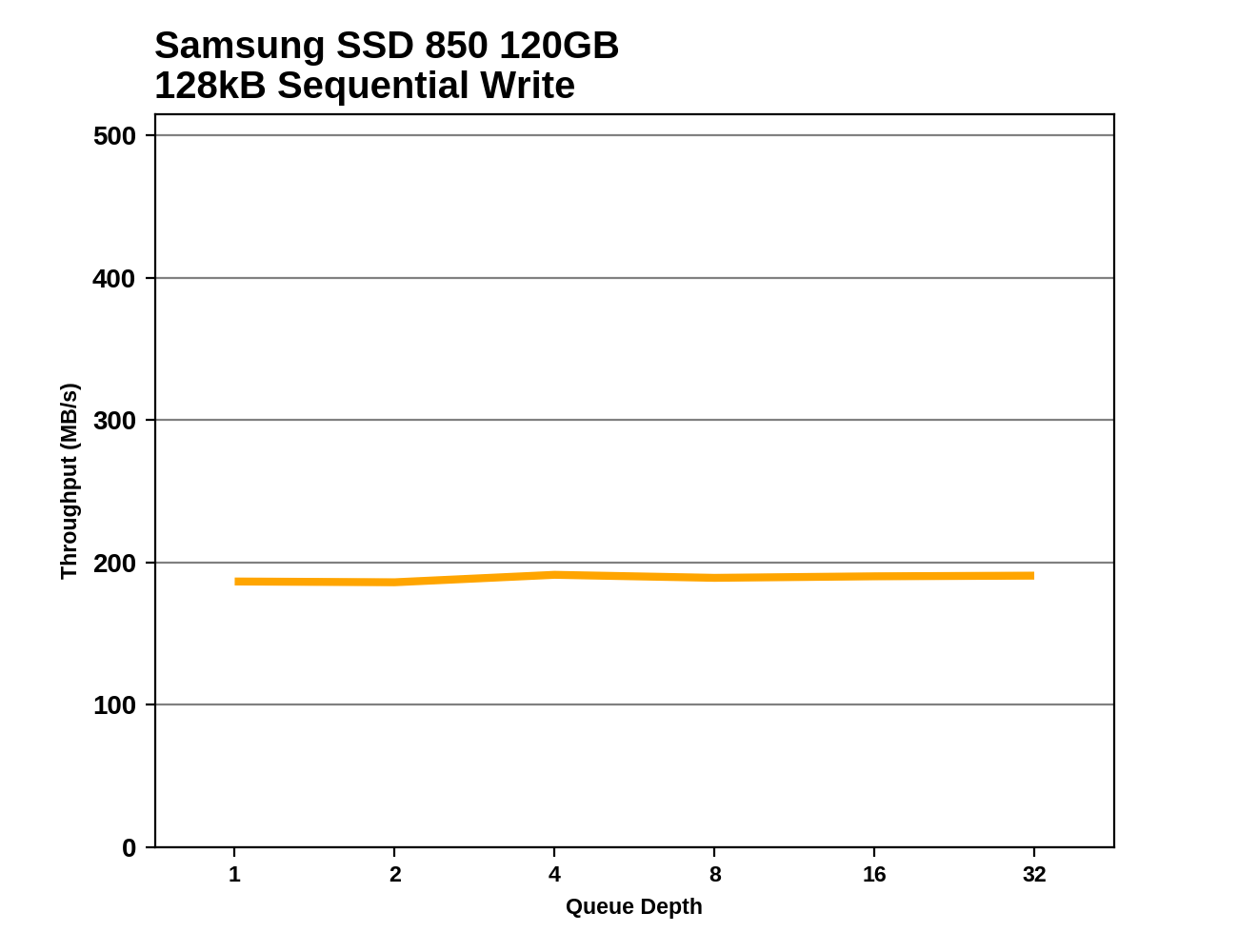The Samsung SSD 850 120GB Review: A Little TLC for SATA
by Billy Tallis on November 27, 2017 12:00 PM ESTSequential Read Performance
Our first test of sequential read performance uses short bursts of 128MB, issued as 128kB operations with no queuing. The test averages performance across eight bursts for a total of 1GB of data transferred from a drive containing 16GB of data. Between each burst the drive is given enough idle time to keep the overall duty cycle at 20%.

The burst sequential read performance of the Samsung SSD 850 120GB places it in the second tier of 120GB-class drives, but it's actually the fastest of the current models. The performance is a clear improvement over the 850 EVO but is about the same as the 750 EVO and the HP S700.
Our test of sustained sequential reads uses queue depths from 1 to 32, with the performance and power scores computed as the average of QD1, QD2 and QD4. Each queue depth is tested for up to one minute or 32GB transferred, from a drive containing 64GB of data.

On the longer test of sequential reads, the Samsung 850 falls well below the standard set by Samsung's earlier drives and ends up slightly slower than the HP S700. The S700 Pro and ADATA SU800 are in last place with less than half the performance of the 850 120GB.
 |
|||||||||
Most drives show no performance scaling with queue depth on the sequential read test. The older Samsung drives all show some improvement from QD1 to QD2 and are steady after that, while the 850 120GB is simply the same speed across the board.
Sequential Write Performance
Our test of sequential write burst performance is structured identically to the sequential read burst performance test save for the direction of the data transfer. Each burst writes 128MB as 128kB operations issued at QD1, for a total of 1GB of data written to a drive containing 16GB of data.

The short burst sequential write speed of the Samsung SSD 850 120GB is comparable to Samsung's other drives in this capacity class, and is better than any other current drive for this segment.
Our test of sustained sequential writes is structured identically to our sustained sequential read test, save for the direction of the data transfers. Queue depths range from 1 to 32 and each queue depth is tested for up to one minute or 32GB, followed by up to one minute of idle time for the drive to cool off and perform garbage collection. The test is confined to a 64GB span of the drive.

On the longer sequential write test, the Samsung SSD 850 120GB is tied for second place, though the performance of the 850 PRO far outshines everything else.
 |
|||||||||
As with sequential reads, most of these drives handle sequential writes at the same speed regardless of queue depth. The 850 PRO is the only one to show substantial improvement as queue depths increase. Several other drives experience temporary hits to their write performance as a result of their SLC write caches filling and forcing the drive to perform garbage collection, but most are steady through most of the test.










31 Comments
View All Comments
lilmoe - Monday, November 27, 2017 - link
Oh, and so are the Pros... hmmm.Is that a holiday discount or is it that I haven't checked the price in a while?
Arbie - Tuesday, November 28, 2017 - link
Great article, even though its subject is a minor league item. AT quality.bug77 - Tuesday, November 28, 2017 - link
That's the ugly face of SSD: the cheaper they make them, the more we lose durability and access speed...bcronce - Tuesday, November 28, 2017 - link
Still 1000x faster than a mechanical drive, perceptibly as fast as any other SSD for most situations, and will last a lifetime.mapesdhs - Wednesday, November 29, 2017 - link
Definitely will not last a lifetime, and some newer models can have worse steady state performance than a rust spinner.bcronce - Wednesday, November 29, 2017 - link
Even the infamous Samsung 840s were still out-performing 15k SAS drives in their degraded modes. I see free "crackerjack" USB 2.0 flash drives out performing my 7.2k RPM rust buckets.MamiyaOtaru - Thursday, November 30, 2017 - link
no you don'tyifu - Saturday, December 2, 2017 - link
power efficiency test pleaseyifu - Sunday, December 3, 2017 - link
Billy , I would really want to see , is not only the speed , but the power efficiency for a older laptop like my MacBook Pro 13in 2012. if some one really care about speed , they will go for 850 pro 850 EVO, or PCIE. my gaming PC is with 960 pro for windows and 850 evo for storage. my iMac for work is with apple PCIE and a Toshiba HK4R 960GB (power lost protection). SATA speed for a ssd is done.the speed difference between those cheap SSDs are to small.I am thinking to "upgrade" my MacBook Pro mid 2012 from 840 pro to a slower but very very power efficient SSD.
finefunny - Sunday, December 3, 2017 - link
The company has already released several new versions of its OEM models, such as the PM871b, with 64-layer V-NAND. These drives often sell in basic systems from Dell, Lenovo, and other OEM brands. Customers often do not select the components in those systems, so the OEM models fly under the radar.Samsung isn't saying much for now, but it should answer our questions in early 2018. That's when we expect it to roll out new retail SSDs.